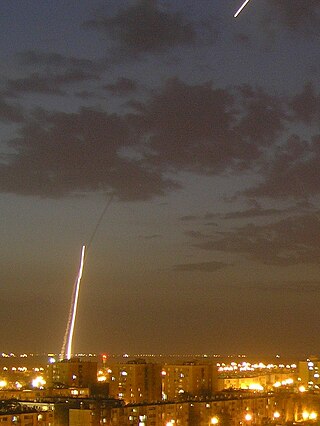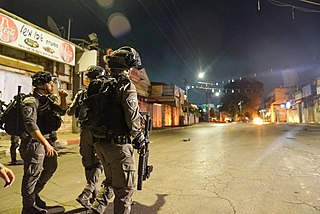Related Research Articles
The Izz ad-Din al-Qassam Brigades, named after Izz ad-Din al-Qassam, is the military wing of the Palestinian organization Hamas. Currently led by Mohammed Deif, IQB is the largest and best-equipped militant group operating within Gaza today.
Jamal Abu Samhadana, from Rafah in the Gaza Strip, was the founder and leader of the Popular Resistance Committees, a former Fatah and Tanzim member, and number two on Israel's list of wanted terrorists.

The state of human rights in the West Bank and Gaza Strip is determined by Palestinian as well as Israeli policies, which affect Palestinians in the occupied Palestinian territories both directly and indirectly, through their influence over the Palestinian Authority (PA). Based on The Economist Democracy Index this state is classified as an authoritarian regime.

The 2006 Gaza–Israel conflict, known in Israel as Operation Summer Rains, was a series of battles between Palestinian militants and the Israel Defense Forces (IDF) during summer 2006, prompted by the capture of Israeli soldier Gilad Shalit by Palestinian militants on 25 June 2006. Large-scale conventional warfare occurred in the Gaza Strip, starting on 28 June 2006, which was the first major ground operation in the Gaza Strip since Israel's unilateral disengagement plan was implemented between August and September 2005.
This is the Timeline of the Israeli–Palestinian conflict in 2007.

In 2008, Israel sought to halt the rocket and mortar fire from Gaza that killed four Israeli civilians that year and caused widespread trauma and disruption of life in Israeli towns and villages close to the Gaza border. In addition, Israel insisted that any deal include an end to Hamas's military buildup in Gaza, and movement toward the release of Corporal Gilad Shalit. Hamas wanted an end to the frequent Israeli military strikes and incursions into Gaza, and an easing of the economic blockade that Israel has imposed since Hamas took over the area in 2007.
The Gaza–Israel conflict is a localized part of the Israeli–Palestinian conflict beginning in 1948, when 200,000 Palestinians fled or were expelled from their homes, settling in the Gaza Strip as refugees. Since then, Israel has fought 15 wars against the Gaza Strip. The number of Gazans reportedly killed in the most recent 2023 war — 34,000 — is higher than the death toll of all other wars of the Arab-Israeli conflict.

The Gaza War, also known as Operation Cast Lead, also known as the Gaza Massacre, and referred to as the Battle of al-Furqan by Hamas, was a three-week armed conflict between Gaza Strip Palestinian paramilitary groups and the Israel Defense Forces (IDF) that began on 27 December 2008 and ended on 18 January 2009 with a unilateral ceasefire. The conflict resulted in 1,166–1,417 Palestinian and 13 Israeli deaths. Over 46,000 homes were destroyed in Gaza, making more than 100,000 people homeless.

In November 2012, the Israel Defense Forces (IDF) launched Operation Pillar of Defense, which was an eight-day campaign in the Hamas-governed Gaza Strip, beginning on 14 November 2012 with the killing of Ahmed Jabari, chief of the Gaza military wing of Hamas, by an Israeli airstrike.
The 2012 Israeli operation in the Gaza Strip was a military operation carried out in the Gaza Strip by the Israel Defense Forces starting on 14 November 2012, following rocket attacks on Israeli territory launched from Gaza during the preceding days.

The 2014 Gush Etzion kidnapping and murder refers to the abduction and killing of three Israeli teenagers in the West Bank during June 2014. The victims, Eyal Yifrach, Gilad Shaer, and Naftali Fraenkel, were Israeli students aged 16 and 19. On the evening of 12 June 2014, the three teenagers were hitchhiking in the Alon Shvut settlement in Gush Etzion, in the West Bank when they were abducted.

The 2014 Gaza War, also known as Operation Protective Edge, and Battle of the Withered Grain, was a military operation launched by Israel on 8 July 2014 in the Gaza Strip, a Palestinian territory that has been governed by Hamas since 2007. Following the kidnapping and murder of three Israeli teenagers in the West Bank by Hamas-affiliated Palestinian militants, the Israel Defense Forces (IDF) initiated Operation Brother's Keeper, in which some 350 Palestinians, including nearly all of the active Hamas militants in the West Bank, were arrested. Hamas subsequently fired a greater number of rockets into Israel from the Gaza Strip, triggering a seven-week-long conflict between the two sides. It was one of the deadliest outbreaks of open conflict between Israel and the Palestinians in decades. The combination of Palestinian rocket attacks and Israeli airstrikes resulted in over two thousand deaths, the vast majority of which were Gazan Palestinians. This includes a total of six Israeli civilians who were killed as a result of the conflict.
The following is a timeline of the 2014 Gaza War. Over 2014, Palestinians suffered the highest number of civilian casualties since the Six-Day War in 1967, according to a United Nations report, given the July–August conflict, and rising tolls in the West Bank and East Jerusalem. A spike in Israeli casualties also occurred. 2,256 Palestinians and 85 Israelis died, while 17,125 Palestinians, and 2,639 Israelis suffered injuries.

The Palestinian Security Services (PSS) are the armed forces and intelligence agencies of the State of Palestine. They comprise several institutions, notably the Security Forces and the Police. The President of the Palestinian National Authority is Commander-in-Chief of the Palestinian Forces.

Gaza-Israel clashes began on 11 November 2018, when a botched Israeli covert operation carried out in the Khan Yunis area of the southern Gaza Strip killed seven Palestinian militants and one Israeli soldier. Exchanges of fire lasted for two more days, until a cease fire was achieved with Egyptian mediation. Some minor incidents and protests followed some two weeks after the cease fire, with decreasing intensity.

A Gaza–Israel conflict escalation began on 3 May 2019 after two Israeli soldiers were injured by sniper fire from the Gaza Strip during the weekly protests at the Gaza–Israel border. In response, the Israeli Air Force carried out an airstrike, killing two Palestinians. Following this, hundreds of rockets were launched from Gaza at Israel, while the Israeli Air Force struck numerous targets within the Gaza Strip. In addition, Israel increased its troop presence near the Israel–Gaza barrier.

A major outbreak of violence in the ongoing Israeli–Palestinian conflict commenced on 10 May 2021, though disturbances took place earlier, and continued until a ceasefire came into effect on 21 May. It was marked by protests and police riot control, rocket attacks on Israel by Hamas and Palestinian Islamic Jihad (PIJ), and Israeli airstrikes in the Gaza Strip. The crisis was triggered on 6 May, when Palestinians in East Jerusalem began protesting over an anticipated decision of the Supreme Court of Israel on the eviction of six Palestinian families in the East Jerusalem neighborhood of Sheikh Jarrah. Under international law, the area, effectively annexed by Israel in 1980, is a part of the Israeli-occupied West Bank; On 7 May, according to Israel's Channel 12, Palestinians threw stones at Israeli police forces, who then stormed the Al-Aqsa Mosque compound using tear gas, rubber bullets, and stun grenades. The crisis prompted protests around the world as well as official reactions from world leaders.
The year 2023 in Israel was defined first by wide-scale protests against a proposed judicial reform, and then by the Hamas-led attack on Israel on October 7, which led to a war and to Israel invading the Gaza Strip.
References
- ↑ Hamas disbands Executive Force, absorbs troops into police (Extra) Monsters and Critics.
- ↑ Hamas frees 150 prisoners from Gazan jails Xinhua News Agency.
- ↑ Hamas: 120 police dead, 95% of security buildings demolished and hundreds of civilians slain Ma'an News Agency.